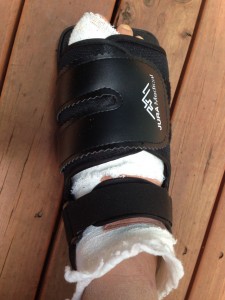I have to admit I’m a bit chicken when it comes to having surgery of any description. My fear must have started way back in the 1980’s when a family friend had to have a very simple procedure to have some cysts removed. Very unfortunately, the anesthesiologist didn’t monitor her vital signs properly. Elena didn’t regain her senses and passed away a few days after.
All the same, probably since such a terrible situation took place far away and long ago, when I had to have urgent surgery to fix a right wrist fracture in 2010, I just got on with it and went for the chop. This time I had elective surgery to remove a painful bunion on my right foot. I should have done it ages ago, but I wanted to build up the necessary fitness … and find a surgeon I sensed I could communicate with. Sue, a friend of mine, had a similar procedure back in 2014. After having a long conversation with her on her surgery and the specialist that performed it, I decided to ask my GP to give me a referral for Dr Mark Horsley.

I had a “bunionectomy” exactly a week ago. In spite of having to show up at North Shore Private Hospital at the crack of dawn, I was happy to get the procedure done quickly and with a lot less pain than I would have imagined, courtesy of Dr Horsley’s skill and dexterity, and the anesthesiologist’s commitment to sound pain management.
If there’s an anecdote worth mentioning, it involves my less-than-five-minutes conversation with the “gasser” (for those of you not in the know, that’s the UK slang word for anesthesiologist). After discussing the meds I’m on and after-surgery painkillers, there came the moment for Yours Truly to be wheeled to the operating theatre. The assistant surgeon—a smiling and nice looking lady—greeted me affably there while the anesthesiologist busied himself inserting a needle into one of the veins in my left hand.
‘You’ve got small bones,’ he said, or words to that effect. In my pre-surgical confusion, I felt chuffed. Maybe my “small bones” were complicating the poor man’s job, haha! In any case, the needle was soon inserted with minimal pain, with a cannula, tubing and connectors that would stay there until my discharge the following day.
I had become weirdly jocular and asked, ‘So when would you like to start counting up to ten, doctor?’ ‘No need to,’ was the reply. ‘That happens only in the movies. We do know when the patient’s asleep,’ added the good doctor.
Note to self before I went unconscious and knew nothing more: never make characters in my future novels count up to ten if they’re about to have surgery. It doesn’t happen in real life; it’s only the stuff of ER and House. I wouldn’t mind becoming that successful, but I can also avoid being that corny.
Waking up after surgery was a hoot: I did come to, but was very sleepy because I hadn’t had enough shut-eye the night before, and had the nurse in charge a bit worried. But I managed to gather enough coherence to let her know that I was all right, just horribly tired. I spent the whole day dozing off, which was not such a blessing in the end, because I could barely sleep a wink at night! 🙁
The “Pain” chapter: as the old wives’ tales on bunion surgery go, the pain is just INTOLERABLE! Well, I’m here to tell you that it’s more tolerable than the pain I had to endure before, with my two feet suffering because of the one bunion … I know that surgical techniques have improved dramatically, but I still hear people give hyperbolic accounts on how painful it was. However, I understand that a) the experience of pain is subjective; b) that sometimes surgery isn’t well performed and c) that general fitness also plays a role.
I was more than happy to see Dr Horsley the following day and to be discharged. I was even happier not to need any crutches to walk around! A cane may come in handy, though.
There’s surgery that isn’t urgent, but it’s important. Quality of life can go a long way, and a steady gait has a direct influence on knee, hip and spinal health. Cheers, FFJ (with her feet up)




